+ Open data
Open data
- Basic information
Basic information
| Entry | Database: PDB / ID: 1ikn | ||||||
|---|---|---|---|---|---|---|---|
| Title | IKAPPABALPHA/NF-KAPPAB COMPLEX | ||||||
 Components Components |
| ||||||
 Keywords Keywords | TRANSCRIPTION FACTOR / IKB-NFKB COMPLEX | ||||||
| Function / homology |  Function and homology information Function and homology informationnegative regulation of cholesterol transport / SUMOylation of immune response proteins / Regulated proteolysis of p75NTR / I-kappaB/NF-kappaB complex / negative regulation of vitamin D biosynthetic process / Interleukin-1 processing / DEx/H-box helicases activate type I IFN and inflammatory cytokines production / RIP-mediated NFkB activation via ZBP1 / MAP3K8 (TPL2)-dependent MAPK1/3 activation / TRAF6 mediated NF-kB activation ...negative regulation of cholesterol transport / SUMOylation of immune response proteins / Regulated proteolysis of p75NTR / I-kappaB/NF-kappaB complex / negative regulation of vitamin D biosynthetic process / Interleukin-1 processing / DEx/H-box helicases activate type I IFN and inflammatory cytokines production / RIP-mediated NFkB activation via ZBP1 / MAP3K8 (TPL2)-dependent MAPK1/3 activation / TRAF6 mediated NF-kB activation / positive regulation of hyaluronan biosynthetic process / NF-kB is activated and signals survival / PKMTs methylate histone lysines / Activation of NF-kappaB in B cells / TAK1-dependent IKK and NF-kappa-B activation / mammary gland involution / Turbulent (oscillatory, disturbed) flow shear stress activates signaling by PIEZO1 and integrins in endothelial cells / FCERI mediated NF-kB activation / CLEC7A (Dectin-1) signaling / Interleukin-1 signaling / antibacterial innate immune response / prolactin signaling pathway / Downstream TCR signaling / negative regulation of myeloid cell differentiation / cellular response to interleukin-17 / NF-kappaB p50/p65 complex / toll-like receptor TLR6:TLR2 signaling pathway / IkBA variant leads to EDA-ID / positive regulation of Schwann cell differentiation / nucleotide-binding oligomerization domain containing 1 signaling pathway / CD209 (DC-SIGN) signaling / response to cobalamin / cellular response to peptidoglycan / positive regulation of lipid storage / negative regulation of interleukin-12 production / SUMOylation of immune response proteins / RIP-mediated NFkB activation via ZBP1 / ankyrin repeat binding / negative regulation of protein sumoylation / nucleotide-binding oligomerization domain containing 2 signaling pathway / postsynapse to nucleus signaling pathway / defense response to tumor cell / nuclear localization sequence binding / cellular response to interleukin-6 / positive regulation of macrophage derived foam cell differentiation / cellular response to dsRNA / non-canonical NF-kappaB signal transduction / actinin binding / negative regulation of non-canonical NF-kappaB signal transduction / response to UV-B / positive regulation of miRNA metabolic process / positive regulation of leukocyte adhesion to vascular endothelial cell / interleukin-1-mediated signaling pathway / signal transduction involved in regulation of gene expression / vascular endothelial growth factor signaling pathway / NF-kappaB complex / toll-like receptor 4 signaling pathway / negative regulation of cytokine production / cellular response to hepatocyte growth factor stimulus / positive regulation of amyloid-beta formation / negative regulation of protein import into nucleus / : / cellular response to cold / phosphate ion binding / response to exogenous dsRNA / cellular response to cytokine stimulus / cellular response to lipoteichoic acid / response to muramyl dipeptide / positive regulation of T cell receptor signaling pathway / TRAF6 mediated NF-kB activation / cellular response to angiotensin / positive regulation of vascular endothelial growth factor production / negative regulation of macrophage derived foam cell differentiation / general transcription initiation factor binding / negative regulation of lipid storage / negative regulation of Notch signaling pathway / positive regulation of cholesterol efflux / canonical NF-kappaB signal transduction / hair follicle development / response to cAMP / lymph node development / positive regulation of transcription initiation by RNA polymerase II / NF-kappaB binding / response to amino acid / neuropeptide signaling pathway / RNA polymerase II core promoter sequence-specific DNA binding / transcription regulator inhibitor activity / Notch signaling pathway / JNK cascade / response to muscle stretch / Neutrophil degranulation / positive regulation of interleukin-12 production / negative regulation of canonical NF-kappaB signal transduction / negative regulation of cytokine production involved in inflammatory response / peptide binding / antiviral innate immune response / negative regulation of insulin receptor signaling pathway / protein sequestering activity / response to progesterone / negative regulation of miRNA transcription Similarity search - Function | ||||||
| Biological species |   Homo sapiens (human) Homo sapiens (human) | ||||||
| Method |  X-RAY DIFFRACTION / X-RAY DIFFRACTION /  SYNCHROTRON / SYNCHROTRON /  MOLECULAR REPLACEMENT / Resolution: 2.3 Å MOLECULAR REPLACEMENT / Resolution: 2.3 Å | ||||||
 Authors Authors | Huxford, T. / Huang, D.-B. / Malek, S. / Ghosh, G. | ||||||
 Citation Citation |  Journal: Cell(Cambridge,Mass.) / Year: 1998 Journal: Cell(Cambridge,Mass.) / Year: 1998Title: The crystal structure of the IkappaBalpha/NF-kappaB complex reveals mechanisms of NF-kappaB inactivation. Authors: Huxford, T. / Huang, D.B. / Malek, S. / Ghosh, G. | ||||||
| History |
|
- Structure visualization
Structure visualization
| Structure viewer | Molecule:  Molmil Molmil Jmol/JSmol Jmol/JSmol |
|---|
- Downloads & links
Downloads & links
- Download
Download
| PDBx/mmCIF format |  1ikn.cif.gz 1ikn.cif.gz | 135.9 KB | Display |  PDBx/mmCIF format PDBx/mmCIF format |
|---|---|---|---|---|
| PDB format |  pdb1ikn.ent.gz pdb1ikn.ent.gz | 104.4 KB | Display |  PDB format PDB format |
| PDBx/mmJSON format |  1ikn.json.gz 1ikn.json.gz | Tree view |  PDBx/mmJSON format PDBx/mmJSON format | |
| Others |  Other downloads Other downloads |
-Validation report
| Summary document |  1ikn_validation.pdf.gz 1ikn_validation.pdf.gz | 449.2 KB | Display |  wwPDB validaton report wwPDB validaton report |
|---|---|---|---|---|
| Full document |  1ikn_full_validation.pdf.gz 1ikn_full_validation.pdf.gz | 491.9 KB | Display | |
| Data in XML |  1ikn_validation.xml.gz 1ikn_validation.xml.gz | 30.3 KB | Display | |
| Data in CIF |  1ikn_validation.cif.gz 1ikn_validation.cif.gz | 41.7 KB | Display | |
| Arichive directory |  https://data.pdbj.org/pub/pdb/validation_reports/ik/1ikn https://data.pdbj.org/pub/pdb/validation_reports/ik/1ikn ftp://data.pdbj.org/pub/pdb/validation_reports/ik/1ikn ftp://data.pdbj.org/pub/pdb/validation_reports/ik/1ikn | HTTPS FTP |
-Related structure data
| Related structure data | 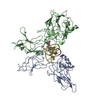 1vkxS S: Starting model for refinement |
|---|---|
| Similar structure data |
- Links
Links
- Assembly
Assembly
| Deposited unit | 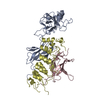
| ||||||||
|---|---|---|---|---|---|---|---|---|---|
| 1 |
| ||||||||
| Unit cell |
|
- Components
Components
| #1: Protein | Mass: 32738.027 Da / Num. of mol.: 1 / Fragment: N-TERMINAL AND DIMERIZATION DOMAINS Source method: isolated from a genetically manipulated source Source: (gene. exp.)   |
|---|---|
| #2: Protein | Mass: 13929.799 Da / Num. of mol.: 1 / Fragment: N-TERMINAL AND DIMERIZATION DOMAINS Source method: isolated from a genetically manipulated source Source: (gene. exp.)   |
| #3: Protein | Mass: 26098.195 Da / Num. of mol.: 1 Source method: isolated from a genetically manipulated source Source: (gene. exp.)  Homo sapiens (human) / Gene: MAD-3 / Species (production host): Escherichia coli / Production host: Homo sapiens (human) / Gene: MAD-3 / Species (production host): Escherichia coli / Production host:  |
| #4: Water | ChemComp-HOH / |
-Experimental details
-Experiment
| Experiment | Method:  X-RAY DIFFRACTION / Number of used crystals: 5 X-RAY DIFFRACTION / Number of used crystals: 5 |
|---|
- Sample preparation
Sample preparation
| Crystal | Density Matthews: 2.41 Å3/Da / Density % sol: 43 % | ||||||||||||||||||||||||||||||||||||||||
|---|---|---|---|---|---|---|---|---|---|---|---|---|---|---|---|---|---|---|---|---|---|---|---|---|---|---|---|---|---|---|---|---|---|---|---|---|---|---|---|---|---|
| Crystal grow | pH: 7 / Details: pH 7.00 | ||||||||||||||||||||||||||||||||||||||||
| Crystal | *PLUS Density % sol: 43 % | ||||||||||||||||||||||||||||||||||||||||
| Crystal grow | *PLUS Temperature: 23-24 ℃ / Method: vapor diffusion, hanging drop | ||||||||||||||||||||||||||||||||||||||||
| Components of the solutions | *PLUS
|
-Data collection
| Diffraction | Mean temperature: 105 K |
|---|---|
| Diffraction source | Source:  SYNCHROTRON / Site: SYNCHROTRON / Site:  NSLS NSLS  / Beamline: X25 / Wavelength: 1.54 / Beamline: X25 / Wavelength: 1.54 |
| Detector | Detector: CCD |
| Radiation | Protocol: SINGLE WAVELENGTH / Monochromatic (M) / Laue (L): M / Scattering type: x-ray |
| Radiation wavelength | Wavelength: 1.54 Å / Relative weight: 1 |
| Reflection | Resolution: 2.3→30 Å / Num. obs: 28014 / % possible obs: 91 % / Observed criterion σ(I): 1 / Redundancy: 3.5 % / Biso Wilson estimate: 25.5 Å2 / Rmerge(I) obs: 0.043 / Net I/σ(I): 15.1 |
| Reflection shell | Resolution: 2.3→2.38 Å / Rmerge(I) obs: 0.22 / Mean I/σ(I) obs: 2.5 / % possible all: 59 |
| Reflection | *PLUS Highest resolution: 2.3 Å / Lowest resolution: 30 Å / % possible obs: 91 % / Redundancy: 3.5 % / Num. measured all: 160828 |
| Reflection shell | *PLUS Highest resolution: 2.3 Å / Lowest resolution: 2.38 Å / % possible obs: 59 % / Mean I/σ(I) obs: 2.5 |
- Processing
Processing
| Software |
| ||||||||||||||||||||||||||||||||||||||||||||||||||||||||||||
|---|---|---|---|---|---|---|---|---|---|---|---|---|---|---|---|---|---|---|---|---|---|---|---|---|---|---|---|---|---|---|---|---|---|---|---|---|---|---|---|---|---|---|---|---|---|---|---|---|---|---|---|---|---|---|---|---|---|---|---|---|---|
| Refinement | Method to determine structure:  MOLECULAR REPLACEMENT MOLECULAR REPLACEMENTStarting model: PDB ENTRY 1VKX Resolution: 2.3→6 Å / σ(F): 3
| ||||||||||||||||||||||||||||||||||||||||||||||||||||||||||||
| Displacement parameters | Biso mean: 48.6 Å2
| ||||||||||||||||||||||||||||||||||||||||||||||||||||||||||||
| Refine analyze |
| ||||||||||||||||||||||||||||||||||||||||||||||||||||||||||||
| Refinement step | Cycle: LAST / Resolution: 2.3→6 Å
| ||||||||||||||||||||||||||||||||||||||||||||||||||||||||||||
| Refine LS restraints |
| ||||||||||||||||||||||||||||||||||||||||||||||||||||||||||||
| LS refinement shell | Resolution: 2.3→2.44 Å / Total num. of bins used: 6
| ||||||||||||||||||||||||||||||||||||||||||||||||||||||||||||
| Xplor file |
| ||||||||||||||||||||||||||||||||||||||||||||||||||||||||||||
| Software | *PLUS Name: CNS / Version: 0.4 / Classification: refinement | ||||||||||||||||||||||||||||||||||||||||||||||||||||||||||||
| Refinement | *PLUS Rfactor obs: 0.223 | ||||||||||||||||||||||||||||||||||||||||||||||||||||||||||||
| Solvent computation | *PLUS | ||||||||||||||||||||||||||||||||||||||||||||||||||||||||||||
| Displacement parameters | *PLUS | ||||||||||||||||||||||||||||||||||||||||||||||||||||||||||||
| Refine LS restraints | *PLUS
| ||||||||||||||||||||||||||||||||||||||||||||||||||||||||||||
| LS refinement shell | *PLUS Rfactor obs: 0.3 |
 Movie
Movie Controller
Controller



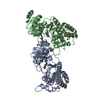
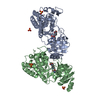
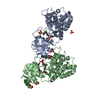

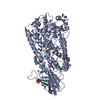
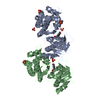

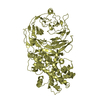

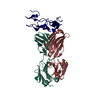
 PDBj
PDBj


























